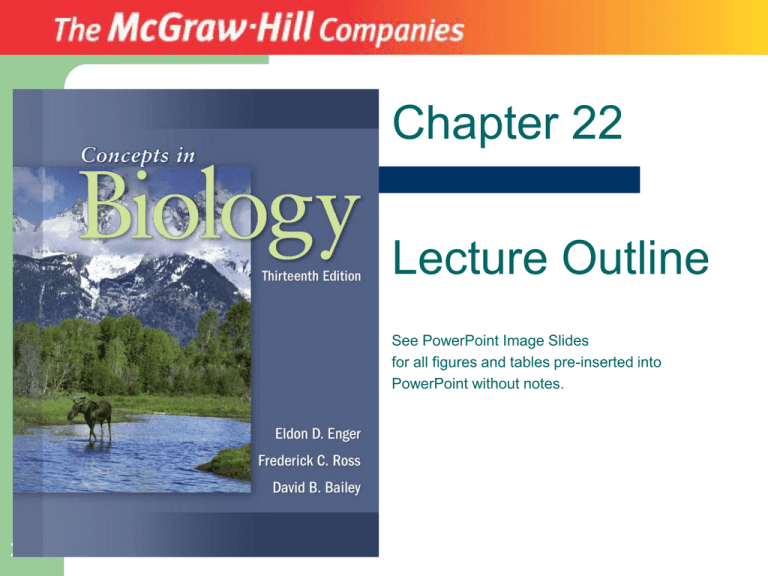CHAPTER 3 ORGANIC CHEMISTRY
advertisement

Chapter 22 Lecture Outline See PowerPoint Image Slides for all figures and tables pre-inserted into PowerPoint without notes. 22-1 What is a plant? Eukaryotic Multicellular Contains chlorophyll a and b Carries on photosynthesis Has cellulose cell walls Lives in a variety of terrestrial habitats – 22-2 And a few shallow aquatic habits Exhibits alternation of generations Copyright © The McGraw-Hill Companies, Inc. Permission required for reproduction or display. Plant Diversity 22-3 Copyright © The McGraw-Hill Companies, Inc. Permission required for reproduction or display. Alternation of Generations A life cycle that involves two generations – Sporophyte generation – Gametophyte generation 22-4 Diploid Undergoes meiosis to generate haploid spores Spores germinate and divide by mitosis to give rise to the gametophyte generation. Multicellular haploid generation Undergoes mitosis to produce haploid gametes Gametes unite to form a zygote. Zygote divides by mitosis to form the sporophyte generation. Copyright © The McGraw-Hill Companies, Inc. Permission required for reproduction or display. Alternation of Generations 22-5 Copyright © The McGraw-Hill Companies, Inc. Permission required for reproduction or display. The Evolution of Plants Photosynthetic algae are thought to be the ancestors of plants. – – The evolution of plants shows two trends. – – 22-6 Green algae have the same types of chlorophyll. There is extensive DNA homology between plants and green algae. Toward greater specialization for living in a dry environment Toward a more prominent sporophyte generation Copyright © The McGraw-Hill Companies, Inc. Permission required for reproduction or display. The Evolution of Plants Primitive plants – – – – More advanced plants – – – 22-7 Lack vascular tissue to carry water Have flagellated sperm; no seeds Have to live in moist habitats Have dominant gametophyte generation Have specialized cells that transport water Have seeds that do not require water for distribution Have dominant sporophyte generation Copyright © The McGraw-Hill Companies, Inc. Permission required for reproduction or display. The Taxonomy of Plants 22-8 Copyright © The McGraw-Hill Companies, Inc. Permission required for reproduction or display. Nonvascular Plants Include – Mosses, hornworts, liverworts Known as the bryophytes Common features – Lack vascular tissue – – – Do not have true roots or leaves Gametophyte is dominant Sperm swim to egg – 22-9 Use diffusion and osmosis to obtain water and nutrients Must have water to reproduce sexually Are small and confined to moist habitats Copyright © The McGraw-Hill Companies, Inc. Permission required for reproduction or display. Moss Life Cycle 22-10 Copyright © The McGraw-Hill Companies, Inc. Permission required for reproduction or display. 22-11 http://www.youtube.com/watch?v=jcWYAnm m-QE Copyright © The McGraw-Hill Companies, Inc. Permission required for reproduction or display. Kinds of Nonvascular Plants Mosses – – Liverworts and hornworts – – 22-12 Grow as a carpet of many individual gametophyte plants Each individual is less than 5 cm tall. Form flat sheets only a few cells thick Each cell contains one large chloroplast. Copyright © The McGraw-Hill Companies, Inc. Permission required for reproduction or display. Non-vascular plants 22-13 http://www.youtube.com/watch?v=kBPLKUTt XBM Copyright © The McGraw-Hill Companies, Inc. Permission required for reproduction or display. The Significance of Vascular Tissue Vascular tissue is an adaptation to living in dry environments. – – Allows plants to transport water and nutrients throughout the plant Associated with the development of – – Vascular tissue allowed for an increase in plant size Accompanied by the appearance of a waterproof coating on the plant surfaces Two types of vascular tissue – – 22-14 Leaves for photosynthesis Roots for absorbing water and minerals Xylem Phloem Copyright © The McGraw-Hill Companies, Inc. Permission required for reproduction or display. Xylem A series of dead, hollow cells that form tubes – Vessel elements – Tracheids 22-15 Form long tubes with cells end-to-end Tapered cells with holes Overlap to form a sieve-like tube The walls of these cells are strengthened by cellulose and lignin. Transports water and minerals from the soil to the leaves Copyright © The McGraw-Hill Companies, Inc. Permission required for reproduction or display. Xylem 22-16 Copyright © The McGraw-Hill Companies, Inc. Permission required for reproduction or display. Phloem Carries organic molecules produced in the leaves to the rest of the plant – – Sugar Amino acids Consists of two types of cells – Sieve-tube elements – Companion cells 22-17 Lack a nucleus and organelles, but have cytoplasm Have holes in the end walls for the transport of material Actively transport sugars and amino acids out of the leaf cells and into the sieve-tube elements Copyright © The McGraw-Hill Companies, Inc. Permission required for reproduction or display. Phloem 22-18 Copyright © The McGraw-Hill Companies, Inc. Permission required for reproduction or display. Video Xylem and phloem 22-19 http://www.youtube.com/watch?v=J1PqUB7T u3Y Copyright © The McGraw-Hill Companies, Inc. Permission required for reproduction or display. The Development of Roots, Stems, and Leaves 22-20 The appearance of vascular tissue allowed for the development of specialized plant parts. Roots are specialized for absorption. Stems are specialized for transport. Leaves are specialized for photosynthesis. Copyright © The McGraw-Hill Companies, Inc. Permission required for reproduction or display. Roots Underground parts of a plant that – – Anchor in the soil Absorb water and nutrients Grow from the tips – – Explore new areas of soil for water and nutrients Root tips have root hairs that increase their absorptive surface. Can be important storage sites – – 22-21 Move the nutrients into the vascular system Many plants store carbohydrates in their roots during growing season to be used during the winter. Carrots, turnips, radishes, maple trees, rhubarb, grasses Copyright © The McGraw-Hill Companies, Inc. Permission required for reproduction or display. Kinds of Roots 22-22 Copyright © The McGraw-Hill Companies, Inc. Permission required for reproduction or display. Stems Above-ground structures that – – – Vary greatly in diameter and length – – – 22-23 Support the leaves Transport raw material from the roots to the leaves Transport manufactured material from the leaves to other parts of the plant Tree trunks are large and support branches. Dandelion stems are short. Some stems are underground. Copyright © The McGraw-Hill Companies, Inc. Permission required for reproduction or display. Stems The structure of cell walls allows the stem to support the leaves. – Cell walls are made of cellulose interwoven into a box. – Woody plants have especially thick cell walls. 22-24 When cells are full of water, the cell walls will not stretch. This makes the cells turgid, stiff and able to support weight. These have lignin in them. Allows woody plants to grow tall and withstand wind Copyright © The McGraw-Hill Companies, Inc. Permission required for reproduction or display. Stems Stems contain a lot of vascular tissue. Stems also – Store food – – Photosynthesize Have waterproof layers 22-25 Sugar cane Yams Potatoes Can be waxy or woody Copyright © The McGraw-Hill Companies, Inc. Permission required for reproduction or display. Leaves Specialized for photosynthesis – – – Have large surface area to collect sunlight Relatively thin to allow light penetration Have bundles of vascular tissue to transport – – 22-26 Water and minerals needed for photosynthesis into the leaf The sugar that is made out of the leaf Thick cell walls for support Are arranged to minimize shading of lower leaves Copyright © The McGraw-Hill Companies, Inc. Permission required for reproduction or display. The Structure of a Leaf 22-27 Copyright © The McGraw-Hill Companies, Inc. Permission required for reproduction or display. Leaves Specialized for photosynthesis – Covered by a waxy coating to minimize water loss 22-28 Water evaporates from leaves through transpiration. – Pulls water and nutrients up from the roots – Transpiration must be regulated so plant doesn’t lose too much water. – Water and oxygen exit, and carbon dioxide enters, through stomata. Copyright © The McGraw-Hill Companies, Inc. Permission required for reproduction or display. Stomates 22-29 Copyright © The McGraw-Hill Companies, Inc. Permission required for reproduction or display. Seedless Vascular Plants Include – – – – Have vascular tissue – Are not limited to aquatic environments Do not have seeds – – 22-30 Whisk ferns Horsetails Club mosses Ferns Have flagellated sperm Must have moist conditions to reproduce Copyright © The McGraw-Hill Companies, Inc. Permission required for reproduction or display. Fern Life Cycle 22-31 Copyright © The McGraw-Hill Companies, Inc. Permission required for reproduction or display. Kinds of Seedless Vascular Plants Ferns – Most common seedless vascular plant Whisk ferns – – Lack roots and leaves Anchored by an underground stem 22-32 Modifications of the stem serve the functions of roots and leaves. Copyright © The McGraw-Hill Companies, Inc. Permission required for reproduction or display. Kinds of Vascular Seedless Plants Horsetails – – – Club mosses – – – 22-33 Low-growing plants with jointed stems Most photosynthesis occurs in the stems. Have silicon dioxide in their cell walls Called (and used as) scouring brushes by pioneers Usually evergreen Low-growing, branching plants Some are called ground pines. Copyright © The McGraw-Hill Companies, Inc. Permission required for reproduction or display. Seed-producing Vascular Plants A seed is a specialized structure that contains – – – Seeds allow plants to live in dry habitats. – Aid in dispersal Gymnosperms and angiosperms produce seeds. Accompanied by the development of pollen – – 22-34 An embryo Stored food A protective outer coating (seed coat) that prevents drying Encased sperm (male gametophyte generation) Allows plants to reproduce without water Copyright © The McGraw-Hill Companies, Inc. Permission required for reproduction or display. Gymnosperms Means “naked seed” Woody, perennial plants Produce seeds that are not enclosed (naked) – 22-35 Produce seeds in cones Copyright © The McGraw-Hill Companies, Inc. Permission required for reproduction or display. The Pine Life Cycle 22-36 Copyright © The McGraw-Hill Companies, Inc. Permission required for reproduction or display. Kinds of Gymnosperms Cycads – – Wood plants with a ring of fern-like leaves at the top Live in tropical regions Ginkgo – – Ginkgo biloba is the only living species A tree with fan-shaped leaves 22-37 Used in many herbal medicines Copyright © The McGraw-Hill Companies, Inc. Permission required for reproduction or display. Kinds of Gymnosperms Conifers – – – Trees and shrubs that bear cones Have needle-shaped leaves Called evergreens because they do not lose their leaves – 22-38 Do shed needles throughout the year Used in the production of lumber Copyright © The McGraw-Hill Companies, Inc. Permission required for reproduction or display. Several Gymnosperms 22-39 Copyright © The McGraw-Hill Companies, Inc. Permission required for reproduction or display. Angiosperms Produce flowers Have vascular tissue, seeds and pollen Have seeds enclosed in a fruit – 22-40 A modification of the ovary wall Copyright © The McGraw-Hill Companies, Inc. Permission required for reproduction or display. Flower Structure Composed of highly modified leaves – – – Petals are usually colorful. Sepals surround petals Petals and sepals are arranged in whorls. Specialized for sexual reproduction Female parts in the center – Pistil (stigma, style and ovary) 22-41 Ovary produces eggs Copyright © The McGraw-Hill Companies, Inc. Permission required for reproduction or display. Flower Structure Male parts surround the pistil. – Stamens (filament and anther) 22-42 Anther produces sperm. Perfect flowers have both pistils and stamens. Imperfect flowers have either pistils or stamens. Copyright © The McGraw-Hill Companies, Inc. Permission required for reproduction or display. Flower Structure 22-43 Copyright © The McGraw-Hill Companies, Inc. Permission required for reproduction or display. The Life Cycle of a Flowering Plant 22-44 Copyright © The McGraw-Hill Companies, Inc. Permission required for reproduction or display. Pollination Strategies Wind – – – Plants with inconspicuous flowers are usually wind-pollinated. Produce large numbers of flowers and pollen Many species are wind-pollinated. – Responsible for hay fever 22-45 Grasses and sedges Aspens, birches and oaks Some people have allergic reactions to pollen. Copyright © The McGraw-Hill Companies, Inc. Permission required for reproduction or display. Strategies for Pollination Animals – Plants with showy flowers are usually animalpollinated. – – Flowers attract insects, birds and small mammals. The animals feed on the nectar and pick up the pollen. 22-46 These flowers usually produce nectar. Also smell good to attract animals Then move to another plant for more nectar, transferring the pollen Copyright © The McGraw-Hill Companies, Inc. Permission required for reproduction or display. Wind- and Insect-pollinated Flowers 22-47 Copyright © The McGraw-Hill Companies, Inc. Permission required for reproduction or display. Fruit A modification of the ovary that contains seeds Involved in dispersal of seeds Many fruits are nutritive to animals. – – 22-48 The animals eat the fruit and ingest the seeds. The seeds pass through the digestive tract unharmed and get “planted” in the animals’ feces. Other fruits burst open and release light seeds that are dispersed by wind. Other fruits have sticky surfaces that cling to animals that pass by. Copyright © The McGraw-Hill Companies, Inc. Permission required for reproduction or display. Types of Fruits 22-49 Copyright © The McGraw-Hill Companies, Inc. Permission required for reproduction or display. Angiosperm Diversity Classified as either monocots or dicots – Refers to the number of cotyledons found in the seeds of the species – Cotyledons (seed leaves) store food for the growing embryo. 22-50 Monocots have one cotyledon (peanut). Dicots have two cotyledons (lima bean). They emerge as the first leaves. Copyright © The McGraw-Hill Companies, Inc. Permission required for reproduction or display. Embryos in Dicots and Monocots 22-51 Copyright © The McGraw-Hill Companies, Inc. Permission required for reproduction or display. Monocots vs. Dicots 22-52 Copyright © The McGraw-Hill Companies, Inc. Permission required for reproduction or display. Angiosperm Diversity Monocots – – Yuccas and palms are woody. The rest are herbaceous. Dicots – – Mints, carrots, cabbages, mustards, tomatoes and potatoes are herbaceous dicots. Aspen and sagebrush are woody dicots. 22-53 Wheat, rice, corn, sweet potatoes, onions, bananas These are deciduous. Copyright © The McGraw-Hill Companies, Inc. Permission required for reproduction or display. Deciduous Trees Lose their leaves once a year – The bark of the tree is the phloem. – – 22-54 Occurs in the fall before they go dormant Produce a new layer of xylem and phloem each year Therefore, the trunk increases in diameter each year. Copyright © The McGraw-Hill Companies, Inc. Permission required for reproduction or display. Growth of Woody Plants Woody plants have the ability to grow continuously for many years. – 22-55 They get taller and grow in diameter each year. Growth occurs at the tips of the roots and stems. Copyright © The McGraw-Hill Companies, Inc. Permission required for reproduction or display. Growth of Woody Plants Grow in diameter by adding new xylem and phloem to the outside of the stem – Vascular cambium is made of xylem in the middle and phloem around the perimeter (bark) – The cambium is responsible for lateral growth. – 22-56 Between the xylem and phloem is the cambium. Cambium cells go thought mitosis, making two cells. One cell remains cambium; the other cell forms vascular tissue. As the xylem accumulates, it becomes wood. Copyright © The McGraw-Hill Companies, Inc. Permission required for reproduction or display. A Cross Section of Woody Stem 22-57 Copyright © The McGraw-Hill Companies, Inc. Permission required for reproduction or display. Plant Responses to their Environment Plants are constantly changing in response to changes in their environment. – – – 22-58 They produce flowers at certain times of year. Grow toward the light Can mount an attack against a competitor Copyright © The McGraw-Hill Companies, Inc. Permission required for reproduction or display. Tropisms Growth toward or away from a stimulus Phototropism – – Growing toward light Involves a hormone called auxin 22-59 The tip of the stem produces auxin – Transported into the stem on the shaded side – Stimulates cells on that side to divide and elongate – Causes the stem to bend toward the light Copyright © The McGraw-Hill Companies, Inc. Permission required for reproduction or display. Phototropism 22-60 Copyright © The McGraw-Hill Companies, Inc. Permission required for reproduction or display. Tropisms Thigmotropism – – – – 22-61 Climbing vines can wrap around an object using tendrils. Tendrils wave about and when they touch an object, they wrap around it. Once attached, the tendrils harden. Sweet peas, grape vines and ivy exhibit thigmotropism. Copyright © The McGraw-Hill Companies, Inc. Permission required for reproduction or display. Thigmotropism 22-62 Copyright © The McGraw-Hill Companies, Inc. Permission required for reproduction or display. Seasonal Responses Plants can measure the length of the day. – – Plants can sense changes in temperature. – In dormant plants, warming of the soil triggers above ground growth. Plants can sense the amount of water. – – 22-63 In response to day length, plants make hormones that trigger development of fruit or flowers. In deciduous trees, shortening days triggers leaves to fall off. During dry seasons, certain plants will lose their leaves and go dormant. When it begins to rain, these plants begin to grow and flower. Copyright © The McGraw-Hill Companies, Inc. Permission required for reproduction or display. Response to Injury Plants are attacked by pathogens and herbivores. Plants can fight infection and repair damage by forming scar tissue. Plants defend themselves against predation. – – 22-64 By producing toxins that interfere with herbivores’ metabolism Once leaves are eaten, the new leaves produce even more toxin. Copyright © The McGraw-Hill Companies, Inc. Permission required for reproduction or display. Coevolution of Plants and Animals Plants evolved before animals. – Insects and amphibians followed terrestrial plants. Symbiotic relationships evolved between plants and animals. – Many flowering plants are pollinated by insects and birds. – Grasses and grazers have coevolved. – Grass has silicon that wears down grazers’ teeth. Grazers have very long teeth that take a long time to wear down. Many angiosperms produce nutritive fruit. 22-65 These flowers are brightly colored, have nectar and have odor. Animals eat the fruit and distribute the seeds. Copyright © The McGraw-Hill Companies, Inc. Permission required for reproduction or display.








